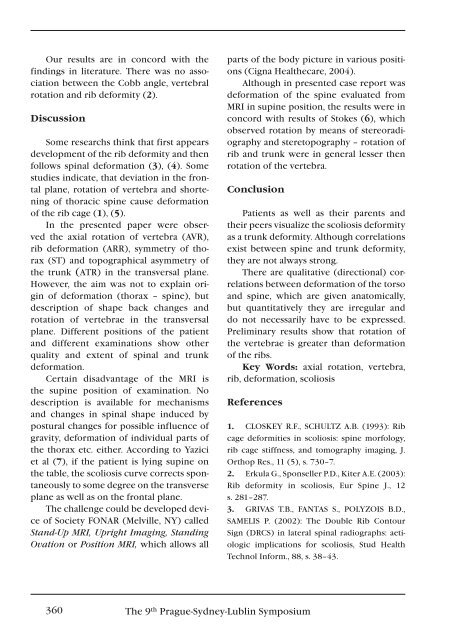Supplementum 3+4/2007 - SpoleÄnost pro pojivové tkánÄ›
Supplementum 3+4/2007 - SpoleÄnost pro pojivové tkánÄ›
Supplementum 3+4/2007 - SpoleÄnost pro pojivové tkánÄ›
You also want an ePaper? Increase the reach of your titles
YUMPU automatically turns print PDFs into web optimized ePapers that Google loves.
Our results are in concord with the<br />
findings in literature. There was no association<br />
between the Cobb angle, vertebral<br />
rotation and rib deformity (2).<br />
Discussion<br />
Some researchs think that first appears<br />
development of the rib deformity and then<br />
follows spinal deformation (3), (4). Some<br />
studies indicate, that deviation in the frontal<br />
plane, rotation of vertebra and shortening<br />
of thoracic spine cause deformation<br />
of the rib cage (1), (5).<br />
In the presented paper were observed<br />
the axial rotation of vertebra (AVR),<br />
rib deformation (ARR), symmetry of thorax<br />
(ST) and topographical asymmetry of<br />
the trunk (ATR) in the transversal plane.<br />
However, the aim was not to explain origin<br />
of deformation (thorax – spine), but<br />
description of shape back changes and<br />
rotation of vertebrae in the transversal<br />
plane. Different positions of the patient<br />
and different examinations show other<br />
quality and extent of spinal and trunk<br />
deformation.<br />
Certain disadvantage of the MRI is<br />
the supine position of examination. No<br />
description is available for mechanisms<br />
and changes in spinal shape induced by<br />
postural changes for possible influence of<br />
gravity, deformation of individual parts of<br />
the thorax etc. either. According to Yazici<br />
et al (7), if the patient is lying supine on<br />
the table, the scoliosis curve corrects spontaneously<br />
to some degree on the transverse<br />
plane as well as on the frontal plane.<br />
The challenge could be developed device<br />
of Society FONAR (Melville, NY) called<br />
Stand-Up MRI, Upright Imaging, Standing<br />
Ovation or Position MRI, which allows all<br />
parts of the body picture in various positions<br />
(Cigna Healthecare, 2004).<br />
Although in presented case report was<br />
deformation of the spine evaluated from<br />
MRI in supine position, the results were in<br />
concord with results of Stokes (6), which<br />
observed rotation by means of stereoradiography<br />
and steretopography – rotation of<br />
rib and trunk were in general lesser then<br />
rotation of the vertebra.<br />
Conclusion<br />
Patients as well as their parents and<br />
their peers visualize the scoliosis deformity<br />
as a trunk deformity. Although correlations<br />
exist between spine and trunk deformity,<br />
they are not always strong.<br />
There are qualitative (directional) correlations<br />
between deformation of the torso<br />
and spine, which are given anatomically,<br />
but quantitatively they are irregular and<br />
do not necessarily have to be expressed.<br />
Preliminary results show that rotation of<br />
the vertebrae is greater than deformation<br />
of the ribs.<br />
Key Words: axial rotation, vertebra,<br />
rib, deformation, scoliosis<br />
References<br />
1. CLOSKEY R.F., SCHULTZ A.B. (1993): Rib<br />
cage deformities in scoliosis: spine morfology,<br />
rib cage stiffness, and tomography imaging, J.<br />
Orthop Res., 11 (5), s. 730–7.<br />
2. Erkula G., Sponseller P.D., Kiter A.E. (2003):<br />
Rib deformity in scoliosis, Eur Spine J., 12<br />
s. 281–287.<br />
3. GRIVAS T.B., FANTAS S., POLYZOIS B.D.,<br />
SAMELIS P. (2002): The Double Rib Contour<br />
Sign (DRCS) in lateral spinal radiographs: aetiologic<br />
implications for scoliosis, Stud Health<br />
Technol Inform., 88, s. 38–43.<br />
360 The 9 th Prague-Sydney-Lublin Symposium
















